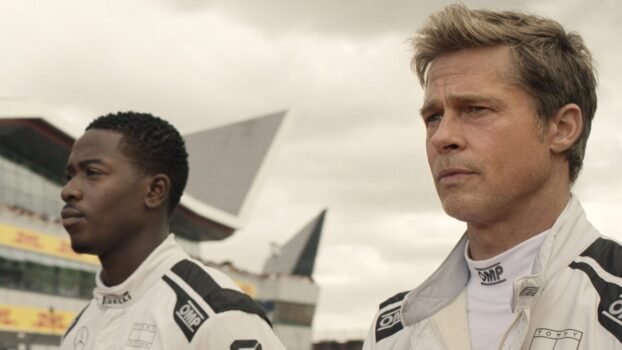I don’t particularly enjoy sports. Nor do I enjoy sports movies. Not unless there’s some kind of underlying drama pushing forth the action and engaging me with the characters and themes. Most films do have this, sure. However, there’s a difference between a well-done drama such as The Wrestler and an inspiring been there, done that movie like Remember the Titans. Both films are solid, but the former comes off much more original than the latter. F1 lands in the second camp. While it does have themes that connect its characters, these fit into a rather formulaic framework. Furthermore, the rhythm of the action-dialogue-action formula flow, in which the film finds itself, drowns out most interest.

A Second Chance
F1 features Brad Pitt as Sonny Hayes, a down-on-his-luck former professional race car driver who now lives out of his van, bouncing from job to job and competition to competition. He’s made a series of seriously poor life choices. These have cost him multiple marriages and have saddled him with a gambling addiction. When old friend Ruben Cervantes (No Country for Old Men’s Javier Bardem) offers him a second chance at Formula One stardom, he accepts.

But it’s going to be tough going for Sonny. The team he’s joining, APX, is at the bottom of the racing food chain. Their second driver is out for the season, and Cervates’ investors will fire him if he doesn’t score a win by the end of the season. To make matters worse, Joshua Pearce (Damson Idris), the teammate that Hayes will be joining, is similar in temperament to him. He’s stubborn, unwavering, and cocky. Will Sonny and Josh be able to find a way to drop their attitudes and work together? If you’ve seen a movie like this one, then you probably know the answer.
The Usual Roles
Brad Pitt plays his usual stock character, a charming rogue who doesn’t play by the rules. As a racer, he lives to engage in questionable tactics, purposefully existing in those grey areas that bring negative attention to himself. It’s his rule-breaking that at first gets Sonny off on the wrong foot with Josh. Both actors are fine in their roles; both showcasing their character’s bravado and huge egos. Brad Pitt, of course, brings the charm as Sonny, living for the moment, as he woos his love interest, Kate McKenna, (Kerry Condon) the APX technical director. She’s been warned not to fall for his bad-boy shenanigans, but fall she does.
Back to the Glory Days
Most of the film’s main themes are explored through digging through Sonny’s motivation for wanting to return to the F1 formula in the first place. See, he was professionally and personally humiliated as a driver back in the day after his crash on the track. As an aging egotistic driver (a fact Pearce insults him for time and time again), Sonny is not a particularly introspective character, but his relationships with Josh and Kate lead him to evaluate why he drives in the first place. He overcomes his reluctance to take on a teammate and the two brash drivers form an unlikely alliance.
Bardem showcases good character acting as someone who’s desperate to succeed, with his team on the edge of falling apart and his professional business millions in the hole. Condon is likewise charming as McKenna, who brings out the soft spots in Sonny, warming to his questionable racing methods.

However, most of this character work takes place in the latter half of the film, with the beginning of the movie switching between primarily two modes: the race action scenes and a few minutes of dialogue as we see our characters plan on how to tackle the next race. By its very nature, a sports movie needs to showcase each match. Yet, that doesn’t change the fact that the film loses itself in this established rhythm and becomes rather a bore to watch after a while when you know exactly what its next step will be. The fact that the character drama mostly occurs at the latter half of the film, while also being so stereo-typically written contributes to the film’s next major problem.
On the Track
With fast paced, high-octane action, the racing would keep anyone on the edge their seat. That is, except for the fact that characters haven’t particularly been developed well by the point the action starts. Add in the fact that these two stubborn rivals/teammates are stock/archetypal characters instead of original ideas, and it’s hard to invest emotionally in them. The racers find themselves on the track, engaging in exciting and pulse-pounding close calls through track twist after turn. I found myself disengaging with the movie, not caring about what was ultimately occurring onscreen. If one is watching this movie for the action, they will receive what they came for. However, my lack of caring, and my expectation that the next match would echo the last, left me unimpressed.

I thought that the ending of the film might do something different and was genuinely intrigued at the turn it might take, but it ultimately plays it safe, when it could have taken a more original turn. The addition of a last-minute villain, Tobias Menzies (Peter Banning), whose ultimate motivation is nothing more than greed, doesn’t do much to add anything to differentiate itself from the pack.
Feel Good Sports
Ultimately F1 exists with simple themes and a formulaic plot. The film weaves itself with well-directed but ultimately unfulfilling action scenes. The movie exists as a vehicle to show off its cars and actors. It’s designed to make you feel good at the moment, but it doesn’t leave much to chew on. I haven’t ever been to a racetrack to watch an actual match, but I suspect it might feel much the same. Long and by the numbers. My overall rating for this one will come in at merely good, with a score of
Score: 7/10
F1 is now playing in theatres nationwide.




